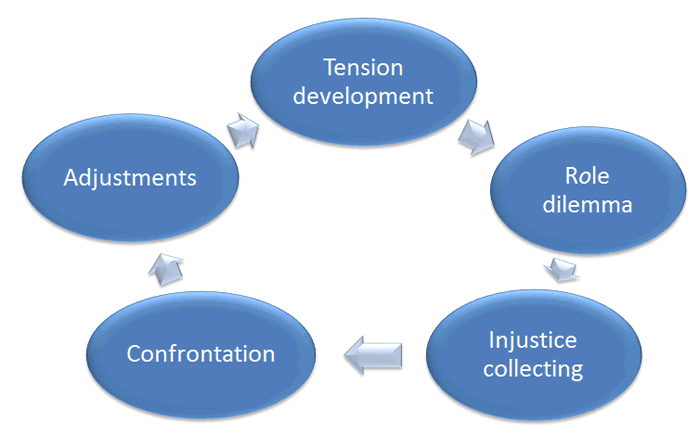Robinson (1978) identified the now widely recognized Conflict Cycle – the stages that most community conflicts go through. While it is worth noting that real life is not as discrete or as linear as the this graph might suggest, and that different stakeholders may reach each point at different times, the value of this cycle lies in using it as a diagnostic tool for determining what’s going on and how you might best intervene.

Tension development
Parties begin taking sides. Tension development may appear immediately or over time.
Intervention opportunity: gathering and providing objective information, listening to all sides, reframing the issue or problem.
Role dilemma
People involved start asking questions: what is happening, who is right, what should be done? Based on this information they may try to take sides. This may happen at the same time as tension development.
Intervention opportunity: gathering and providing objective information, listening to all sides, reframing the challenge, leading a discussion to help all sides see the complexity, values, and perceptions around the issue. Building trust, emphasizing recognition of common ground, identify appropriate jurisdiction issues.
Injustice collecting
Each side seeks to gather support. Each itemizes the problem, justifies their position, and thinks of either revenge or strategies to 'win'.
Intervention opportunity: similar to above, gathering and providing objective information, listening to all sides, reframing the challenge, leading a discussion to help all sides see the complexity, values, and perceptions around the issue, brainstorming causes, alternatives and consequences. This stage of the conflict cycle may be the last chance to build trust and establish sense of common ground with respect to either the issue, a solution, or desired outcome.
Confrontation
The parties meet head-on. If each party holds fast to its side the showdown may cause permanent barriers.
Intervention opportunity: effective facilitation, gathering and providing objective information, listening to all sides, reframing the challenge, highlighting all sides and the complexity, values, and perceptions around the issue. Brainstorm causes, alternatives, consequences, seek win-wins, outline how decisions will be made and steps forward.
Adjustments
Confrontation may be lessened or avoided by one or both parties making adjustments.
Intervention opportunity: emphasizing the win-win while applauding the insights and perspectives of everyone even those who may not be completely satisfied. Providing follow-up information. Consider highlighting lessons learned, etc.
Managing difficult community issues often requires using many of facilitation techniques and strategies discussed elsewhere in this toolbox. In addition, a range of negotiation and collaboration tools may be appropriate. See our resource page for additional examples. A useful framework is provided by the Harvard Negotiating Project 'Getting to Yes' (2011). They outline four key strategies for negotiating solutions to difficult public issues:
- Separate people and their perspectives from the problem. Both are worth considering, but the problem or challenge should be your primary focus
- Focus on eliciting common interests, not positions
- Invent options for mutual gain - seeking to accomplish X while also accomplishing Y, employing 'soft' negotiating tactics
- Insist on using objective criteria for evaluating all your alternatives and consequences

